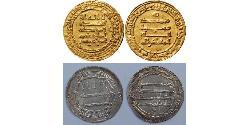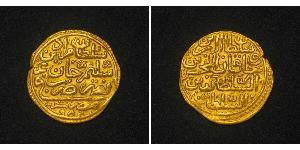(sold for $335.0)
764, Abbasid Empire, Al-Mansur. Scarce Gold D!nar Coin. VF-
Culture: Abbasid Empire
Denomination: Gold D!nar.
Mint Period: 764 AD (144 h.)
Ruler: Al-Mansur (754-775 AD)
Reference: Friedberg 1, Album 212.
Condition: Lightly deformed and clipped, otherwise VF.
Material: Pure Gold!
Diameter: 18mm
Weight: 3.69gm
The Abbasid Caliphate (Arabic: العبّاسيّون, al-‘Abbāsīyūn) was the third of the Islamic Caliphates of the Islamic Empire. It was ruled by the Abbasid dynasty of caliphs, who built their capital in Baghdad after overthrowing the Umayyad caliphs from all but Al Andalus.
It was founded by the descendant of the Prophet Muhammad's youngest uncle, Abbas ibn Abd al-Muttalib. It was created in Harran in 750 and shifted its capital in 762 from Harran to Baghdad. It flourished for two centuries, but slowly went into decline with the rise to power of the Turkish army it had created, the Mamluks. Within 150 years of gaining power across Persia, they were forced to cede power to local dynastic amirs who only nominally acknowledged their power, and had to cede Al Andalus to an escaped Umayyad royal and the Maghreb and Ifriqiya to independent entities such as the Aghlabids and the Fatimids.
Their rule was briefly ended for three years in 1258, when Hulagu Khan, the Mongol conqueror, sacked Baghdad, resuming in Egypt in 1261. They continued to claim authority in religious matters from their base in Mamluk Egypt up to 1519 when power was formally transferred to the Ottomans and the capital transferred to Istanbul.
Al-Mansur or Abu Ja'far Abdallah ibn Muhammad al-Mansur (95 AH – 158 AH (714 AD – 775 AD); Arabic: أبو جعفر عبدالله بن محمد المنصور) was the second Abbasid Caliph from 136 AH to 158 AH (754 AD – 775 AD). He is generally regarded as the real founder of the Abbasid Caliphate.
Al-Mansur was born at the home of the 'Abbasid family after their emigration from the Hejaz in 95 AH (714 AD). "His father, Muhammad, was reputedly a great-grandson of Abbas ibn Abd al-Muttalib, the youngest uncle of Mohammad; his mother, as described in the 14th century Moroccan historical work Rawd al-Qirtas was one Sallama, "a Berber woman given to his father." He reigned from Dhu al-Hijjah 136 AH until Dhu al-Hijjah 158 AH (754 AD – 775 AD). In 762 he founded as new imperial residence and palace city Madinat as-Salam (the city of peace), which became the core of the Imperial capital Baghdad.
Al-Mansur was concerned with the solidity of his regime after the death of his brother, Abu'l `Abbas, who later become known as-Saffah. In 755 he arranged the assassination of Abu Muslim. Abu Muslim was a loyal freed man from the eastern Iranian province of Khorasan who had led the Abbasid forces to victory over the Umayyads during the Third Fitna in 749–750. At the time of al-Mansur he was the subordinate, but undisputed ruler of Iran and Transoxiana. The assassination seems to have been made to preclude a power struggle in the empire, though some findings suggest that Abu Muslim became incredulous and paranoid, thus assassination was necessary and arranged[citation needed].
He deposed Isa ibn Musa as his successor due to suspect of corruption and in his place appointed al-Mahdi as his successor and took public allegiance for him. Like his elder brother Saffah he wanted to unite the land so he get rid of all of his opposition.
During his reign, literature and scholarly work in the Islamic world began to emerge in full force, supported by new Abbasid tolerances for Persians and other groups suppressed by the Umayyads. Although the Umayyad caliph Hisham ibn Abd al-Malik had adopted Persian court practices, it was not until al-Mansur's reign that Persian literature and scholarship were truly appreciated in the Islamic world. The emergence of Shu'ubiya among Persian scholars occurred during the reign of al-Mansur as a result of loosened censorship over Persian nationalism. Shu'ubiya was a literary movement among Persians expressing their belief that Persian art and culture was superior to that of the Arabs; the movement served to catalyze the emergence of Arab-Persian dialogues in the eighth century.
Perhaps more importantly than the emergence of Persian scholarship was the conversion of many non-Arabs to Islam. The Umayyads actively tried to discourage conversion in order to continue the collection of the jizya, or the tax on non-Muslims. The inclusiveness of the Abbasid regime, and that of al-Mansur, saw the expansion of Islam among its territory; in 750, roughly 8% of residents in the Caliphate were Muslims. This would double to 15% by the end of al-Mansur's reign.
In 756, Al-Mansur sent over 4,000 Arab mercenaries to assist the Chinese in the An Shi Rebellion against An Lushan. After the war, they remained in China. Al-Mansur was referred to as "A-p'u-ch'a-fo" in the Chinese T'ang Annals.
Al-Mansur died in 775 on his way to Mecca to make hajj. He was buried somewhere along the way in one of the hundreds of graves that had been dug in order to hide his body from the Umayyads. He was succeeded by his son, al-Mahdi.
According to a number of sources, the Imam Abu Hanifa an-Nu'man was imprisoned by al-Mansur. Imam Malik ibn Anas, the founder of another school of law, was also flogged during his rule, but al-Mansur himself did not condone this – in fact, it was his cousin, who was the governor of Madinah at the time, who did so. Al-Mansur, in turn, punished his cousin, and retributed Imam Malik. (Ya'qubi, vol.III, p. 86; Muruj al-dhahab, vol.III, p. 268–270.)
Al-Masudi in Meadows of Gold recounts a number of anecdotes that present aspects of this caliph's character. He tells of a blind poet on two occasions reciting praise poems for the Umayyads to one he didn't realize was this Abbasid caliph. Al-Mansur rewarded the poet for the verses. Al-Masudi relates a tale of the arrow with verses inscribed on feathers and shaft arriving close to al-Mansur. These verses prompted him to investigate the situation of a notable from Hamadan unjustly imprisoned and release him. There is also the account of the foreboding verses al-Mansur saw written on the wall just before his death.
A very impressive aspect of this caliph's character is that when he died he left in the treasury six hundred thousand dirhams and fourteen million dinars.
In 2008, MBC 1 had depicted the life and leadership of Al-Mansur in a historical series aired during the holy month of Ramadan.
Only 1$ shipping for each additional item purchased!

spa1 » Early Islamic coins - Abbasid ... (10 coins)
The Abbasid Caliphate (750 - 1517) was the third of the Islamic caliphates to succeed the Islamic prophet Muhammad. (after Rashidun Caliphate and Umayyad Caliphate) The Abbasid dynasty descended from Muhammad's youngest uncle, Abbas ibn Abd al- ...

|
Posted by:
anonymous 2014-03-10 |
4 Shilling Bremen (state) Silver
group has 6 coins / 5 prices
⇑
3 Mark Weimar Republic (1918-1933) Silver
group has 53 coins / 52 prices
⇑















-300-150-NVNnnOFsHoMAAAGLvnwX6YNf.jpg)

-300-150-1PoKbzbiZ3cAAAFPzjFtcWLn.jpg)






